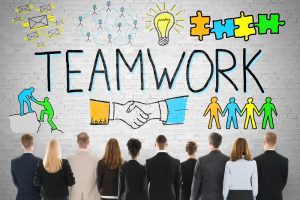0
You have 0 items in your cart


A high-performance culture is important since it is the formula that guides the team, motivates, and inspires employees to perform better. It also attracts the best talent and retains them inside the organization. A high-performance culture attracts and retains the best partners for successful business. What you believe in and stand for will make others want to associate with you. It defines how your team interacts among themselves and with the outside stakeholders specifically customers, media, partners, and suppliers.
The following elements define a company culture:

Paradigm:what the business is, its values, mission, and what it does.

Control systems:Control systems: What process is established to monitor what is going on within the organisation.

Organisation structures:The hierarchy and workflow.

Power structure:the base of power, who makes what decisions and the spread of this power.

Symbols:Includes logos, unique designs, office locations, special parking spaces, and washrooms.

Rituals: these include management meetings, events, and board reports.

Stories and Myths: the values within the organization, stories about the company history, legacy, events, and people.
 Emotional benefits
Emotional benefitsHealthy cultures motivate employees to perform better hence optimum utilization of company resources resulting in better returns.
It helps develop strong relationships for productivity. Since organizations bring together individuals from diverse backgrounds and cultures, a high-performance culture makes all employees work as a motivated team hence personal and organizational productivity.
A high-performance culture makes each one feel part of the team and empowers self-development — both on a professional and a personal level.

With an increase in building the company culture, employees continue to take more personal responsibility for cost minimization to improve business profits.
A favorable attitude at work encourages employees to give their full potential enhancing overall business productivity. This reduces costs of production, resulting in low prices for the products, a better market share, and the growth of the organization.
The company culture acts as a guide to how things should be done. This clear guidance sets the policy that when adhered to results in employees performing tasks as required, therefore attaining company objectives.
 More successful companies
More successful companiesA high-performance culture creates a competitive advantage for the company. This results in clear differentiation, easy access to information and more productive teamwork, hence a workplace that produces better results. Organizations with a high-performance culture tend to ask questions about why they are not optimising then find ways to solve the bottlenecks to productivity.
Such organizations also find it easy to copy effective business strategies from other organizations. This is possible since such organizations can easily share information and work in teams as everyone understands how things are done. You can then customize these strategies and create your own recipe for success.

Being a great place to work is the difference between being a good company and a great company.
When a company establishes strong values and a high-performance culture, it gains both internal and external advantages including:

A company with strong culture influences the clients, potential customers, and suppliers to adopt its culture and way of doing things making the chain one big organization or employees, customers, and suppliers for easy business processes and a stronger competitive advantage.

Strong core values help in decision-making in companies. A good example is a company culture that focuses on quality products, no poor quality product will be allowed to pass through processing or packaging.

With the ease with which people can now search for company information, a high-performance culture acts as a recruiting and retention tool for the best-skilled employees.
The organizations that practice culture experience improved performance while allowing employees to individually achieve their greatness at work. Here are some ways this effort to improve employee performance impacts business sustainability and performance:
1. Improved morale: when your employees feel great about going to work their energy levels are elevated in the entire organization. Employees know that the workplace is where they grow and achieve their potential making them want to work even harder. This is evident in meetings when employees are buzzing and do not want the meeting to end.
2. Increased employee retention: employees only stay at a job because they want to be there. A high-performance culture should make everyone want to be a part of the team for the long run and not just stay because of the money. Start-ups commonly give shares to new employees to make them stay, however, a poor culture will make them leave in spite of that. A supporting environment will automatically make employees do their best and work for many years.
Related article: 5 Tips to Ensure Employee Retention of Remote Workers

4. Boost reputation of the company: with a high-performance culture, an organization will attract competitive candidates whenever a position requires filling. There will be more media coverage of the culture and work environment is favorable.

When you notice the employees adding value to the organization, they should be appreciated both privately and publicly. This can be their positive attitude, the effort put into a project, creativity, among other positive attributes. When employees know you appreciate their input, they will perform even better. People like being appreciated and this is even more valuable to them than money. Do it with sincerity and your organization will greatly benefit.

When you involve employees in the mission and vision of the company and clearly explain to them what the culture of the organization expects, they will do better than if they are left to their own devices. Give them a bigger purpose behind what they are working on and the interest will grow resulting in a stellar performance. An employee will not feel like they matter if no one has spared some time to explain things to them. Each person even the lowest in the hierarchy should be made to feel important to the attainment of the company objectives.

Other than the presence of the employee at work, they bring their history, personal stories, and personal life to work. Take notice of their life and create a connection so that you can better understand where they are coming from, where they are, and where they want to go. This will make them work better knowing that they matter.

Most employees value a company that takes open communication seriously. People prefer being engaged in an organization. They wish to continue contributing ideas and feel they are being heard — it helps to create a sense of belongingness.

The narrative value in your organization goes beyond just telling stories in the annual reports and regular newsletters. When applying narrative through the daily work of the business, its brand identity is made clear and more appealing, the target audience is immediately engaged, and knowledge is easily gathered.
Brand identity: the best way to make the intangible values and attributes of the organization easy to define is by use of stories. Every organization has the big story and the small ones supporting the narrative. The big organization narrative is at the core of the mission and vision. When the smaller stories are shared consistently, your brand is strengthened.

Smart leadership: this is the best easy to build credibility and form trust within your organization. This deepens your relationships with everyone involved with your business.
Knowledge sharing: stories effectively lay the sustainable structure for sharing knowledge and clearly showing the seemingly invisible connections within the organization narrative.

A good example is Coca-Cola and its museum. The world of Cola-Cola showcases the history of this great company containing so many areas of attraction. It takes the visitor through the history of the company from inception through the century.
The setup of the physical environment of a workplace is a major contributing factor in employee productivity. An example is an Open architecture vs. cubical environment. Here is a comparison:

Privacy: Based on what task an employee is assigned, privacy may be needed especially for executives or senior managers. The open plan may not work best for the employee who is always on phone. It should be implemented on a per employee basis.

On Distractions: An open office has one major disadvantage of inability to shut out the interference around you. The distractions can result in reduced productivity for some people.
Transparency: Open architecture creates a sense of transparency. This is towards the customers and fellow employees.
These range from the monthly birthday party or quarterly rewards for best-performing employees. Other than the enjoyment of the party, the organization as a whole can benefit. Employees gain intangibly through these events. The benefits include:

This gives the employees recognition for their accomplishments in their personal lives as well as in the business. Recognitions show the employees that you care and are paying attention to what they do. Involving the organization in personal events like weddings, birthdays, and the birth of new babies make them feel like a part of the community.

Celebrations at the workplace bring employees together from different departments, cultivating better relationships and a sense of unity. It gives the team a chance to bond in a relaxed atmosphere where they can get to know each other better informally.

Recognizing staff during celebrations is a sure way of boosting staff morale even for those who have not received any recognition. It provides an enjoyable time to be off work and just rejoice. This results in better productivity at work.

When employees see their colleagues receive rewards and recognitions, they too get motivated to work harder to increase their chances of being honoured in future celebrations.

The leaders of the organization should take celebrations and organizational traditions seriously due to the following benefits:
Customers will never love a company until the employees love it first
Developing a growth mindset in the organization is beneficial to the business since:
1. It seeks out those who are always eager to learn. The business will not stall as long as employees keep on learning. This will help build a learning organizational culture that empowers innovation and it adapts to changes easily.

3. It builds a culture that is ready to accept risks and accommodate failure. This is the way to decrease stagnation and make employees be creative and try out their ideas.
4. those working at a growth mindset organization feel more committed mainly because they know their growth potential can be realized in that environment. This motivation translates to improved productivity individually and for the organization.

For a business to develop a high-performance culture, the most valuable assets in the organization are your employee. Experiencing the real pleasure of working in a supportive organization is both exciting and stimulating and creates the energy to support a profitable business. This results in genuine enthusiasm and pride in being part of the team and improved productivity for better profits — both financially and emotionally. Employee satisfaction goes hand-in-hand with performance improvement.
Culture is simply a shared way of doing something with a passion.
This Privacy Policy describes how SmartMinds Enterprise OÜ (“SmartMinds”, “we”, “us” or “our”) handles information about yourself that you may provide us with through your use of the Site or Service (“Personal Information”) and should be read along with our Terms of Use posted here, and all other operating rules and additional terms and conditions published on our Site.
SmartMinds is committed to keeping your information secure and managing it in accordance with our legal responsibilities under privacy and data protection laws where we operate. SmartMinds uses your Personal Information only in accordance with this Privacy Policy and Applicable Law. SmartMinds does not sell your Personal Information to third parties. Any capitalized terms not defined in this Privacy Policy are defined in the Terms of Use.
We employ the use of cookies. By using SmartMinds‘s website you consent to the use of cookies in accordance with SmartMinds’s privacy policy.
Most of the modern day interactive web sites use cookies to enable us to retrieve user details for each visit. Cookies are used in some areas of our site to enable the functionality of this area and ease of use for those people visiting. Some of our affiliate / advertising partners may also use cookies.
Unless otherwise stated, SmartMinds and/or it’s licensors own the intellectual property rights for all material on SmartMinds All intellectual property rights are reserved. You may view and/or print pages from https://smartminds.one for your own personal use subject to restrictions set in these terms and conditions.
You must not:
We will approve link requests from these organisations if we determine that: (a) the link would not reflect unfavourably on us or our accredited businesses (for example, trade associations or other organisations representing inherently suspect types of business, such as work-at-home opportunities, shall not be allowed to link); (b)the organisation does not have an unsatisfactory record with us; (c) the benefit to us from the visibility associated with the hyperlink outweighs the absence of SmartMinds; and (d) where the link is in the context of general resource information or is otherwise consistent with editorial content in a newsletter or similar product furthering the mission of the organisation.
These organisations may link to our home page, to publications or to other Web site information so long as the link: (a) is not in any way misleading; (b) does not falsely imply sponsorship, endorsement or approval of the linking party and its products or services; and (c) fits within the context of the linking party’s site.
If you are among the organizations listed in paragraph 2 above and are interested in linking to our website, you must notify us by sending an e-mail to Please include your name, your organisation name, contact information (such as a phone number and/or e-mail address) as well as the URL of your site, a list of any URLs from which you intend to link to our Web site, and a list of the URL(s) on our site to which you would like to link. Allow 2-3 weeks for a response.
Approved organizations may hyperlink to our Web site as follows:
No use of (name)’s logo or other artwork will be allowed for linking absent a trademark license agreement.
Without prior approval and express written permission, you may not create frames around our Web pages or use other techniques that alter in any way the visual presentation or appearance of our Web site.
We shall have no responsibility or liability for any content appearing on your Web site. You agree to indemnify and defend us against all claims arising out of or based upon your Website. No link(s) may appear on any page on your Web site or within any context containing content or materials that may be interpreted as libelous, obscene or criminal, or which infringes, otherwise violates, or advocates the infringement or other violation of, any third party rights.
We reserve the right at any time and in its sole discretion to request that you remove all links or any particular link to our Web site. You agree to immediately remove all links to our Web site upon such request. We also reserve the right to amend these terms and conditions and its linking policy at any time. By continuing to link to our Web site, you agree to be bound to and abide by these linking terms and conditions.
If you find any link on our Web site or any linked web site objectionable for any reason, you may contact us about this. We will consider requests to remove links but will have no obligation to do so or to respond directly to you.
Whilst we endeavour to ensure that the information on this website is correct, we do not warrant its completeness or accuracy; nor do we commit to ensuring that the website remains available or that the material on the website is kept up to date.
We have a 30-day Money Back Guarantee when purchasing Realized Mind, all we ask if that within the 30 days to complete the learning experience and if you truly feel you did not receive any value from the experience we are happy to refund your payment and close your account.
To the maximum extent permitted by applicable law, we exclude all representations, warranties and conditions relating to our website and the use of this website (including, without limitation, any warranties implied by law in respect of satisfactory quality, fitness for purpose and/or the use of reasonable care and skill). Nothing in this disclaimer will:
The limitations and exclusions of liability set out in this Section and elsewhere in this disclaimer: (a) are subject to the preceding paragraph; and (b) govern all liabilities arising under the disclaimer or in relation to the subject matter of this disclaimer, including liabilities arising in contract, in tort (including negligence) and for breach of statutory duty.
To the extent that the website and the information and services on the website are provided free of charge, we will not be liable for any loss or damage of any nature.
